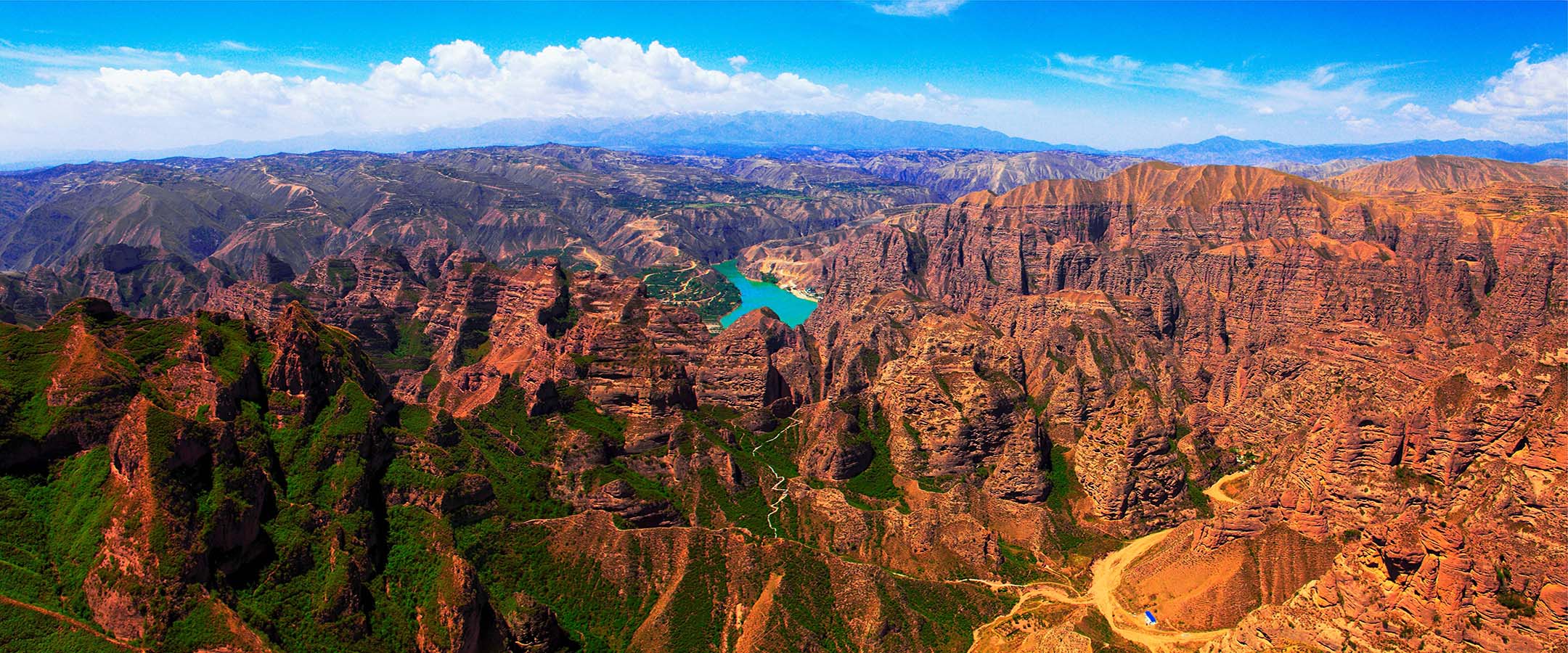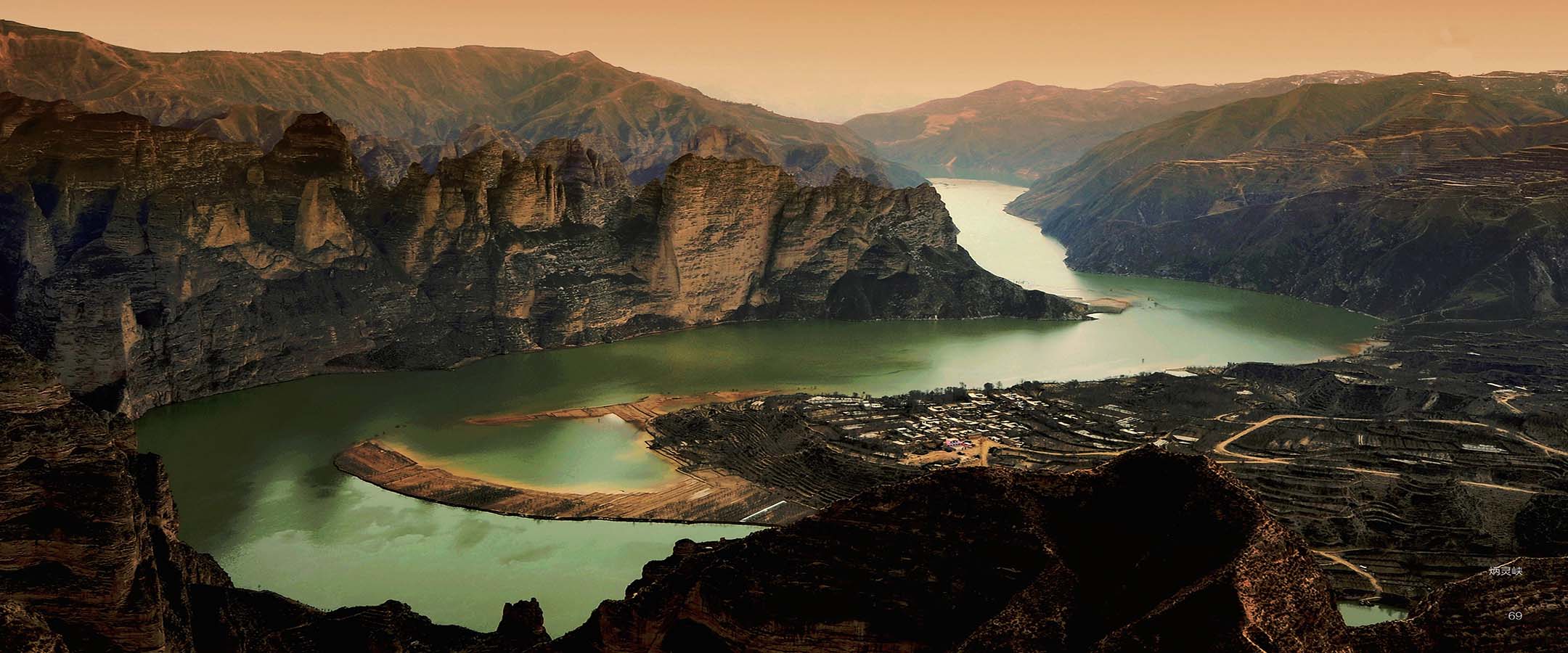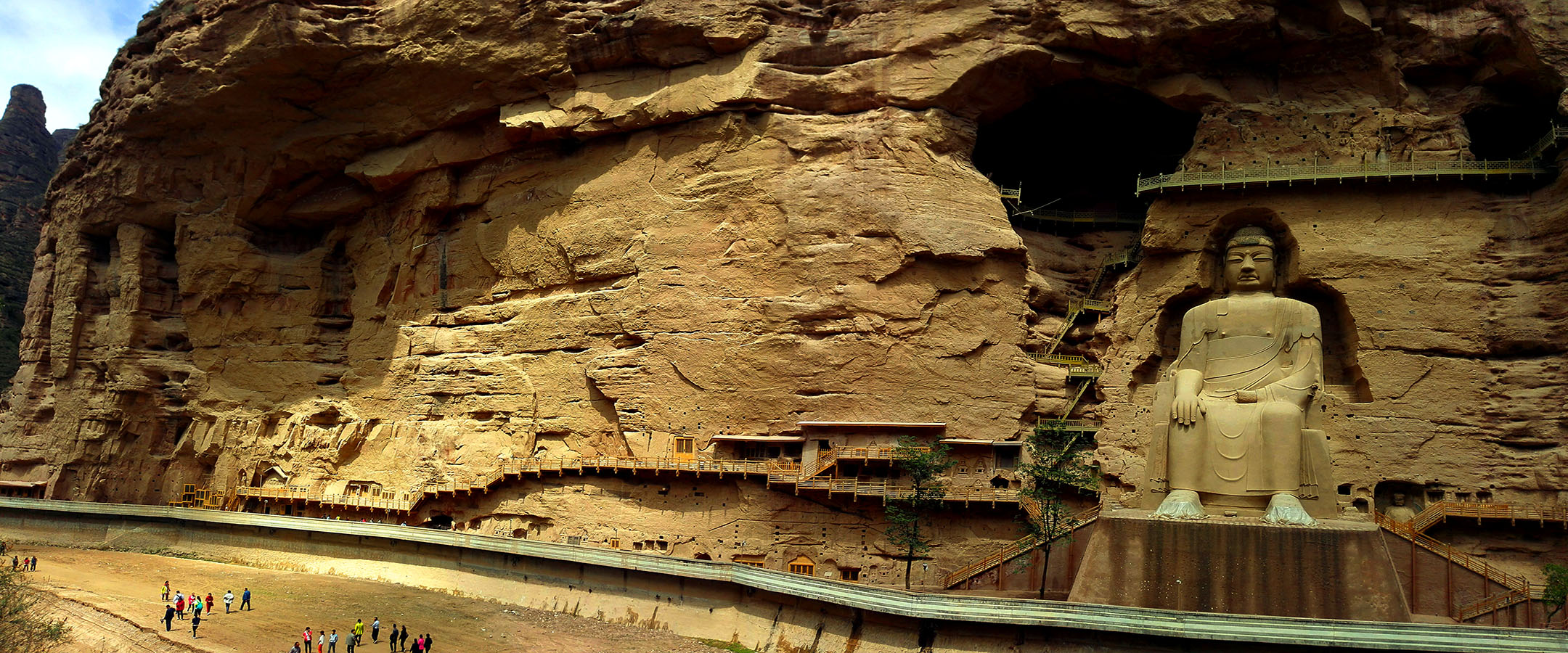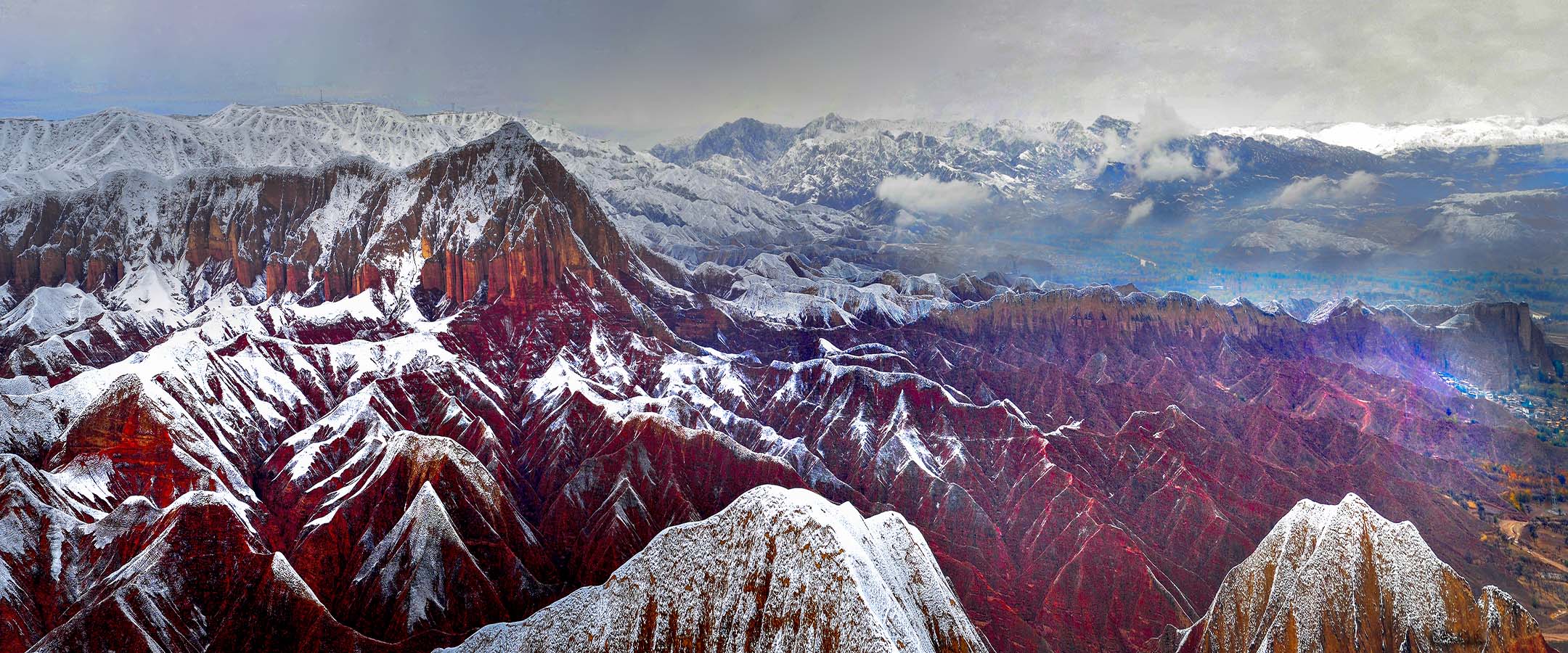人文景观
北乡秧歌虽与北方秦晋秧歌同根同脉,但它却比较完整地保留
了黄河地区文化的古韵遗风,与其他地区的秧歌在表现形式和内容上有着明显的差异,有着浓重而鲜明的地方特色。北乡秧歌有大小两种。大秧歌即是角色齐全的大型秧歌。小秧歌俗称“娃娃秧歌”,一般以青少年为主,人数较少,规模较小,没有财宝神、太夫等角色,服装、乐器都比较简单,且多在村内表演,一般不出村,表演形式也比较单纯,时间较短。北乡秧歌的规模一般在100人左右,多则百人以上,少则80余人,它是有严密组织的临时大型文艺活动团体。其角色齐全,表演形式灵活多样,节目数量繁多,艺术风格与当地群众的风俗习惯、社会风貌、文化观念、欣赏趣味等有着密切的联系。北乡秧歌多为男扮女装,主要在夜间表演,所以有“玩秧歌、打高灯,喜气重重”的民谚。北乡秧歌不仅在村内表演,而且向邻村“送太平”。因表演形式和内容不同,北乡秧歌又分为大场和小场。大场为秧歌开始、结束和过街行进中,变换队形的集体舞。小场俗称“扎场子”,即在固定场院由部分人员表演带有简单情节的舞蹈或歌舞小戏。
北乡秧歌的活动范围,主要在北乡“喇嘛三川”和后川之罗川、白魏家川和孔家寺一带。其中尤以白塔寺川和后川为盛。后川之大川、小川、西河川等地虽属河州北乡,但因接近兰州,秧歌的表演形式与曲调明显带有兰州太平鼓(歌)的某些特点,与北乡秧歌不尽相同。 [2] 永靖县位于甘肃省中部西南,临夏回族自治州北部,素称“河州北乡”。临夏,古称河州。1707年(清康熙四十六年),河州以临夏市为中心,按照地理方位分为东、西、南、北四乡。“北乡”之名从此声播河湟,传袭下来。
河州北乡,起初包括大夏河、黄河、湟水河两岸的喇嘛川、碱土川、白塔寺川(以上通称“喇嘛三川”)、西河川、后川及周边山区。1929年3月永靖建县,县治设在碱土川莲花堡。同时将后川黄河对岸原属皋兰县的“半个川”划归永靖。据1932年县府统计,永靖时辖莲花、河东、太极、大川、西河等9村,有人口11046人。在河州民间的习惯称谓中,北乡成了永靖县的代名词。
Although BEIXIANG Yangko has the same root and vein with that of northern qinjin Yangko, it remains completely
Figure 1 Yangko performance in BEIXIANG, Hezhou
Figure 1 Yangko performance of Hezhou BEIXIANG [1]
There are obvious differences in the form and content of Yangko in the Yellow River area and other areas, with strong and distinctive local characteristics. There are two kinds of Yangko in BEIXIANG. Big Yangko is a large Yangko with complete roles. Xiaoyangko, commonly known as "baby Yangko", is mainly composed of young people, with a small number of people and a small scale. There are no such roles as treasure God and Taifu. The costumes and musical instruments are relatively simple, and most of them are performed in the village. Generally, they do not go out of the village. The performance form is relatively simple and the time is short. The scale of Yangko in BEIXIANG is generally about 100 people, more than 100 people, less than 80 people. It is a large temporary and well-organized literary and art activity group. Its role is complete, the form of performance is flexible and diverse, the number of programs is various, and the artistic style is closely related to the local people's customs, social features, cultural concepts, appreciation interests, etc. BEIXIANG Yangko is mostly dressed up as a man and a woman, mainly performed at night, so there is a folk saying that "playing Yangko, playing high lights, full of joy". BEIXIANG Yangko not only performs in the village, but also "delivers peace" to the neighboring villages. Because of the different forms and contents of the performance, BEIXIANG Yangko can be divided into two parts: big stage and small stage. The stage is a group dance of changing the formation of Yangko at the beginning, end and crossing the street. The small venue is commonly known as "zazhangzi", that is to say, some people perform small dances or singing and dancing plays with simple plots in the fixed venue.
The range of Yangko activities in BEIXIANG is mainly in the areas of "three Lama rivers" in BEIXIANG and Luochuan, baiweijiachuan and kongjiasi in houchuan. Among them, baitasichuan and houchuan are the most prosperous. Although Dachuan, Xiaochuan, xihechuan and other places in houchuan belong to the North Township of Hezhou, because they are close to Lanzhou, the performance form and tune of Yangko obviously have some characteristics of Lanzhou taipinggu (song), which is different from the Yangko in the North Township. [2] Yongjing county is located in the southwest of central Gansu Province, in the north of Linxia Hui Autonomous Prefecture, known as "Hezhou North Township". Linxia, formerly known as Hezhou. In 1707 (the 46th year of Kangxi in the Qing Dynasty), Hezhou was divided into four townships, i.e. East, West, South and North, with Linxia city as the center. From then on, the name of "BEIXIANG" came down.
The North Township of Hezhou initially includes the Lama River, alkaline earth River, White Pagoda Temple River (the three Lama rivers above), West River, houchuan and surrounding mountainous areas on the banks of Daxia River, Yellow River and Huangshui River. In March 1929, Yongjing county was established, and the county government was located in lianhuapu, alkaline soil Sichuan. At the same time, the other side of houchuan Yellow River, which originally belonged to Gaolan County, was classified as Yongjing. According to the statistics of the county government in 1932, Yongjing had jurisdiction over nine villages, including Lianhua, Hedong, Taiji, Dachuan and Xihe, with a population of 11046. In the folk appellation of Hezhou, BEIXIANG has become the pronoun of Yongjing county.
Figure 1 Yangko performance in BEIXIANG, Hezhou
Figure 1 Yangko performance of Hezhou BEIXIANG [1]
There are obvious differences in the form and content of Yangko in the Yellow River area and other areas, with strong and distinctive local characteristics. There are two kinds of Yangko in BEIXIANG. Big Yangko is a large Yangko with complete roles. Xiaoyangko, commonly known as "baby Yangko", is mainly composed of young people, with a small number of people and a small scale. There are no such roles as treasure God and Taifu. The costumes and musical instruments are relatively simple, and most of them are performed in the village. Generally, they do not go out of the village. The performance form is relatively simple and the time is short. The scale of Yangko in BEIXIANG is generally about 100 people, more than 100 people, less than 80 people. It is a large temporary and well-organized literary and art activity group. Its role is complete, the form of performance is flexible and diverse, the number of programs is various, and the artistic style is closely related to the local people's customs, social features, cultural concepts, appreciation interests, etc. BEIXIANG Yangko is mostly dressed up as a man and a woman, mainly performed at night, so there is a folk saying that "playing Yangko, playing high lights, full of joy". BEIXIANG Yangko not only performs in the village, but also "delivers peace" to the neighboring villages. Because of the different forms and contents of the performance, BEIXIANG Yangko can be divided into two parts: big stage and small stage. The stage is a group dance of changing the formation of Yangko at the beginning, end and crossing the street. The small venue is commonly known as "zazhangzi", that is to say, some people perform small dances or singing and dancing plays with simple plots in the fixed venue.
The range of Yangko activities in BEIXIANG is mainly in the areas of "three Lama rivers" in BEIXIANG and Luochuan, baiweijiachuan and kongjiasi in houchuan. Among them, baitasichuan and houchuan are the most prosperous. Although Dachuan, Xiaochuan, xihechuan and other places in houchuan belong to the North Township of Hezhou, because they are close to Lanzhou, the performance form and tune of Yangko obviously have some characteristics of Lanzhou taipinggu (song), which is different from the Yangko in the North Township. [2] Yongjing county is located in the southwest of central Gansu Province, in the north of Linxia Hui Autonomous Prefecture, known as "Hezhou North Township". Linxia, formerly known as Hezhou. In 1707 (the 46th year of Kangxi in the Qing Dynasty), Hezhou was divided into four townships, i.e. East, West, South and North, with Linxia city as the center. From then on, the name of "BEIXIANG" came down.
The North Township of Hezhou initially includes the Lama River, alkaline earth River, White Pagoda Temple River (the three Lama rivers above), West River, houchuan and surrounding mountainous areas on the banks of Daxia River, Yellow River and Huangshui River. In March 1929, Yongjing county was established, and the county government was located in lianhuapu, alkaline soil Sichuan. At the same time, the other side of houchuan Yellow River, which originally belonged to Gaolan County, was classified as Yongjing. According to the statistics of the county government in 1932, Yongjing had jurisdiction over nine villages, including Lianhua, Hedong, Taiji, Dachuan and Xihe, with a population of 11046. In the folk appellation of Hezhou, BEIXIANG has become the pronoun of Yongjing county.













